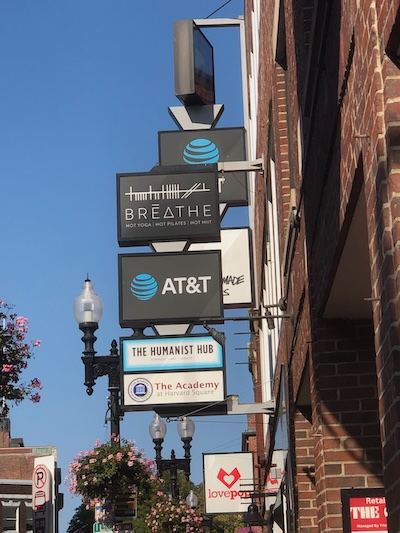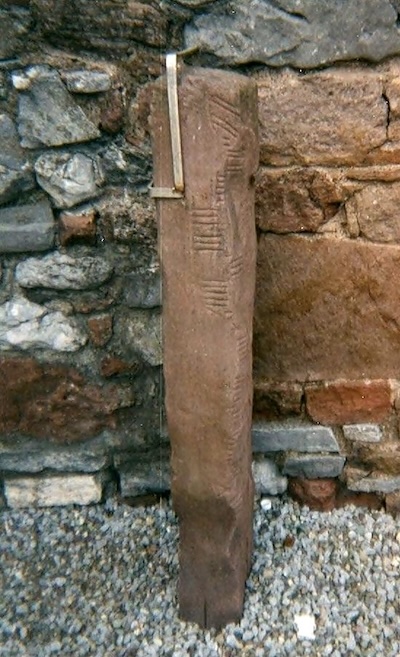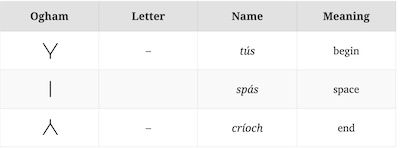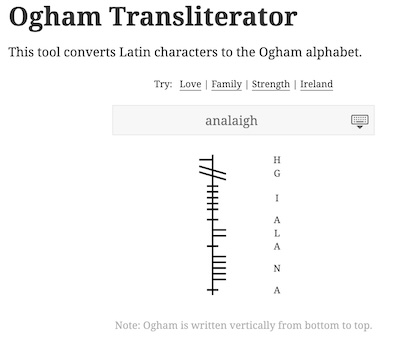Ogham in Harvard Square
Tagged:Obscurantism
/
ϜΤΦ
A couple days ago, I saw something weird in Harvard Square. Nothing weird about that, right?
A Most Peculiar Sign!
 I was walking through Harvard Square in the general vicinity of
Car Talk Plaza, near the former site of the venerable offices of Dewey, Cheatham, and Howe.
I was just minding my own business when one of my background processes reached out the
back of my head, grabbed my ponytail, yanked me around and said, “Lookithat!”
I was walking through Harvard Square in the general vicinity of
Car Talk Plaza, near the former site of the venerable offices of Dewey, Cheatham, and Howe.
I was just minding my own business when one of my background processes reached out the
back of my head, grabbed my ponytail, yanked me around and said, “Lookithat!”
At first, I could tell something was off, but couldn’t quite tell what it was. Look at the signage in this photo (click to embiggen). More or less ordinary signs, until you get to the yoga studio at the top. See that mass of vertical lines, stricken through by a horizontal line? That is what triggered my background process.
I stared at it for a bit, puzzled. (This is perfectly normal behavior in Harvard Square.) Then another background process slapped me around and said “Ooh! Ooh! I know this one!” (Yes, it spoke in the voice of Gunther Toody. Yes, I am old.)
Beginning around 300 - 400 CE in Ireland, there was a style of writing used for Old Irish and Pictish, called “Ogham”. The modern pronunciation would have the “gh” sound sort of like a “w”, though older dialects would have it be a hard “g”. There’s a reasonable tutorial on Ogham.co, if you want to see the various letters.
 Normally it’s written vertically, read from bottom to top.
Normally it’s written vertically, read from bottom to top.
Unusually among all languages, it’s made to be written right on and around the corner of a rectangular stone pillar: half the letters go around to the face on the right, half around to the face on the left, and the edge bisects the whole inscription. It looks, honestly, like some stone-eating creature chewed on the pillar and left teeth marks.
Wikipedia offers us this picture, of an Ogham-inscribed stone in a church in County Kerry, Ireland. The scratch marks that wrap around the corner are Ogham writing.
 There are usually some special arrow-like marks at the bottom and top of the inscription, as shown
here, which basically mean “beginning of text” and “end of text”. When written
horizontally for modern convenience, it is rotated 90 degrees clockwise and a horizontal
bar is used to represent the corner edge of the stone.
There are usually some special arrow-like marks at the bottom and top of the inscription, as shown
here, which basically mean “beginning of text” and “end of text”. When written
horizontally for modern convenience, it is rotated 90 degrees clockwise and a horizontal
bar is used to represent the corner edge of the stone.
It appears that so far, whoever’s doing this has got it mostly right, with only a couple minor errors:
- The begin/end markers are missing.
- Instead of writing horizontally, it should either be written vertically, or, best of all, wrapped around the vertical edge of the sign.
Still, not bad.
 Now let’s work out what it says, if anything. According to the tables of letters, it
spells out “analáigh”. We can check that with the
Ogham transliterator at Ogham.co, and it agrees with my
reading, as shown here.
Now let’s work out what it says, if anything. According to the tables of letters, it
spells out “analáigh”. We can check that with the
Ogham transliterator at Ogham.co, and it agrees with my
reading, as shown here.
Ok, fine… but what’s that? Wiktionary reliably informs us that “analáigh” is a word in (modern) Irish/Gaelige for the verb “breathe”. (Though usually the third ‘a’ has an acute accent, as in á.)
That almost makes sense, since the yoga studio is named “BRĒATHE”, albeit with the incomprehensible macron over the E.
The Weekend Conclusion
At that point, I thought this was the Most Harvard Square Thing Ever: a studio teaching yoga, a discipline imported from the Indian subcontinent, labeled in Modern Irish but spelled using a 1500 year old writing system, to advertise to largely English speakers! I thought this must have been some jape by a bored denizen of the Harvard Department of Celtic Languages & Literature.
But then I just Googled “analaigh” and found thousands of yoga studios, hair salons, and alternative “medical” services. A lot of them use this Ogham inscription (click over to the associated image search), probably copied from each other.
So… our conclusion is correct, but we definitely got there the hard way. Comme d’habitude!
(Ceterum censeo, Trump incarcerandam esse.)
Notes & References
Nope.

Gestae Commentaria
Comments for this post are closed pending repair of the comment system, but the Email/Twitter/Mastodon icons at page-top always work.